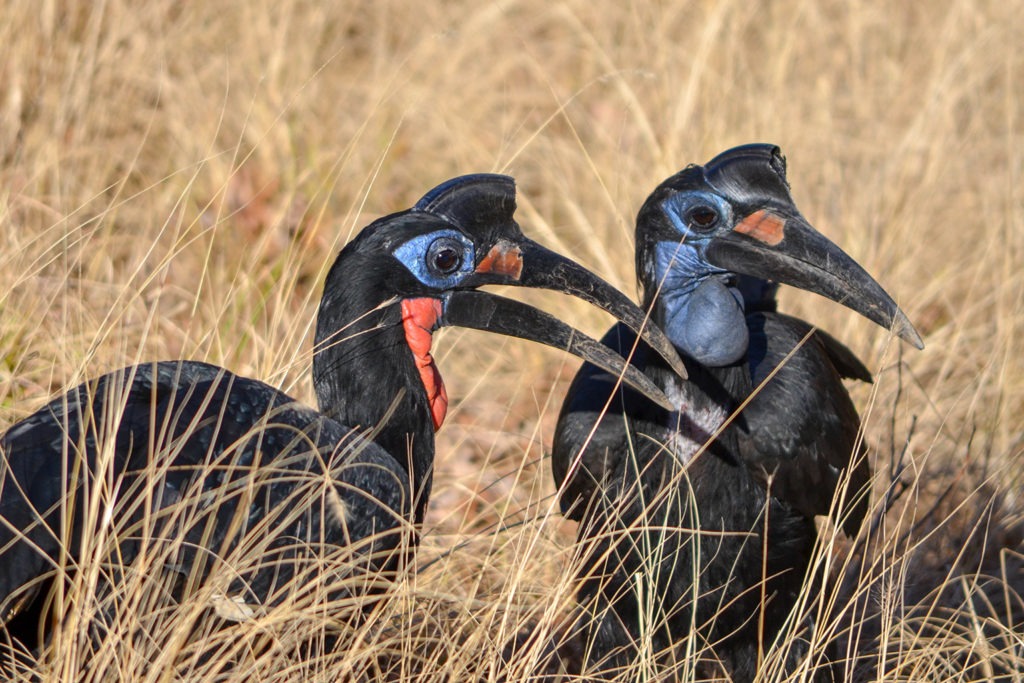Overview
“Where I live”
Northern ground hornbills live on the African savanna north of the equator and south of the Sahara Desert, from forest edge to steppe. See these birds in the African Journey exhibit.
“How I live there”
Northern ground hornbills are imposing birds that are active during the day, foraging and hunting. They inhabit open, dry savannah with little or no grass cover where they usually roam in pairs, or in groups of three or four when young birds are present. They are mostly carnivorous and stride across the savannah using their big bills to subdue prey such as snakes and small mammals. They also pick off smaller prey and eat some fruits and seeds.
Northern ground hornbills rarely fly, preferring to walk or run when threatened (although they can and will fly if forced.)
These birds might also be seen taking dust or rain baths.
“Making my mark”
Northern ground hornbills and Southern ground hornbills are the only two species of ground hornbill. There are 52 other species of hornbill native to either Africa and Asia, and the ground hornbills are different enough from them physically and behaviorally to be classified by some experts as members of a separate family.
Northern ground hornbills and Southern ground hornbills are much larger than all other hornbills. They are easily recognized as hornbills because of their distinctly large beaks topped with bony prominences known as casques. Northern ground hornbills are mostly black with boldly colored skin flaps, or wattles, around the eyes and on the throat. Adult males are marked by a combination of blue and red, whereas females are marked only by blue. All hornbills are also notable for their long eyelashes, which are actually modified feathers.
“What eats me”
Mature Northern ground hornbills are rarely bothered by predators. Chicks and juveniles are more vulnerable, and juveniles take several years to mature fully. When threatened, Northern ground hornbills will raise their heads and expose their throats in a threat posture. They prefer not to fly, but if really disturbed, they will. These birds are not over-hunted, but some native African tribes use the stuffed heads of adult birds as disguise when hunting game. Presumably they must kill some birds in order to make use of their heads. Habitat loss is probably a more significant threat to Northern ground hornbills than hunting, however.
Raising Young
Northern ground hornbills pair up and breed after preparing their nest site together. Females nest in excavated cavities in earthen banks. They lay clutches of 1-2 eggs and incubate them for 37-41 days. Unlike other hornbill species, female ground hornbills do not seal themselves inside their nests during nesting season. Other female hornbills do, using a mixture of mud, food, and droppings.
After hatching, chicks remain in the nest for about 10 days and then start coming out more and more frequently. Usually only one chick survives to fledging. If two chicks hatch, they compete for food from the parents, and the chick that hatched out first usually has a strong advantage. The surviving chick will fledge after 3 months, but will continue to receive food from its parents for up to 9 months. It takes three to four years for juvenile birds to get full adult coloration.
Conservation
Northern ground hornbills are given a conservation status of “least concern” by the IUCN, the world’s leading conservation organization. This does not mean that they are completely unthreatened, however. In some parts of their range, people regard them and other hornbills as sacred and allow them to live unmolested even in areas of dense human settlement. Throughout their range, however, they are pressured by increasing habitat loss.
Taxonomy
- Kingdom: Animalia
- Phylum: Chordata
- Subphylum: Vertebrata
- Class: Aves
- Order: Bucerotiformes
- Family: Bucorvidae
- Genera: Bucorvus
- Species: abyssinicus


